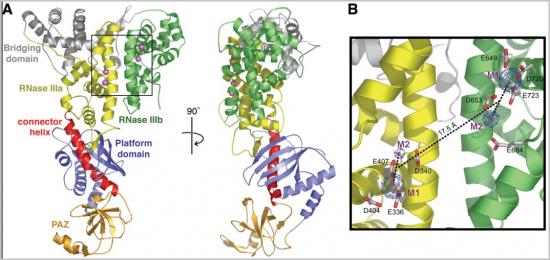背景:动植物基因沉默过程中,发挥显著作用的微RNA (miRNA)长度一般约为22个核苷酸。RNA前体由2个核糖核酸酶依次剪切而成,其中一个是Dicer。过去人们认为, Dicer 利用一个“尺子”机制(即从dsRNA 的3'端来测量其长度)进行剪切,进而把功能性22-核苷酸RNA释放出来。
结论: Narry Kim及其同事发现,Dicer含有一个“凹穴”,识别并结合在RNA前体磷酸化的 5'端上,测算这一端最近的碱基数并进行剪切。Dicer的突变 5' “凹穴”在活体中会影响 miRNA的剪切,从而显示了这种计算机制的重要性。

Dicer功能域的的3维结构,用于剪切miRNA
生物探索推荐英文摘要
Dicer recognizes the 5′ end of RNA for efficient and accurate processing
Abstract:A hallmark of RNA silencing is a class of approximately 22-nucleotide RNAs that are processed from double-stranded RNA precursors by Dicer. Accurate processing by Dicer is crucial for the functionality of microRNAs (miRNAs). The current model posits that Dicer selects cleavage sites by measuring a set distance from the 3′ overhang of the double-stranded RNA terminus. Here we report that human Dicer anchors not only the 3′ end but also the 5′ end, with the cleavage site determined mainly by the distance (~22 nucleotides) from the 5′ end (5′ counting rule). This cleavage requires a 5′-terminal phosphate group. Further, we identify a novel basic motif (5′ pocket) in human Dicer that recognizes the 5′-phosphorylated end. The 5′ counting rule and the 5′ anchoring residues are conserved in Drosophila Dicer-1, but not in Giardia Dicer. Mutations in the 5′ pocket reduce processing efficiency and alter cleavage sites in vitro. Consistently, miRNA biogenesis is perturbed in vivo when Dicer-null embryonic stem cells are replenished with the 5′-pocket mutant. Thus, 5′-end recognition by Dicer is important for precise and effective biogenesis of miRNAs. Insights from this study should also afford practical benefits to the design of small hairpin RNAs.







